
The Eternal Champions Comic: Sooner Than Later God Will Cut You Down
April 18th, 2011 by Gavok | Tags: eternal champions, fighting games, jon haward, michael cook, Video Games(Special thanks to Fletcher “Syrg” Arnett for his assistance)
With the new Mortal Kombat game coming out tomorrow, it feels right to cover another comic based on a game that tried to ape the series’ success with lesser results. Already, I’ve covered Killer Instinct and Primal Rage. Now it’s time for Eternal Champions, a short-lived backup featured in the UK publication Sonic the Comic. Sonic the Comic was a bi-weekly anthology featuring stories about Sega’s rodent mascot with the occasional backups of other Sega properties. It’s mostly remembered in the comic world for a series of Streets of Rage stories written by one Mark Millar. Eternal Champions got two story arcs and a special one-shot issue out of the deal.
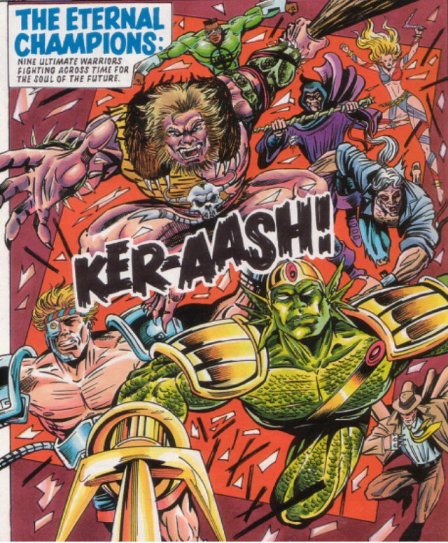
So what is Eternal Champions? The game was released on the Genesis in the early 90’s, followed soon after by an updated version with an expanded roster on the Sega CD. The game had a really cool and inventive storyline… until it remembers the part that it’s a fighting game and it falls apart. The idea is that there’s this being called the Eternal Champion and he’s a big force for good. In the distant future, he comes to realize that the balance between good and evil is way out of whack. Evil’s held its grip over history a bit too much and this will cause a major cataclysm. He notices a handful of beings who were killed before their prime from different time periods. People who would have made the world a better place had their lives not been cut so short.
The Eternal Champion decides to use his powers to bring in these nine souls (more in the Sega CD game) in an attempt to help set things right. It’s like Exiles with time travel. Despite having the power to pull them all from the time stream, he only has the strength to send one of these guys back a moment before their scheduled death. That’s a weird drawback, but okay. I was thinking you could blame the butterfly effect on that, but even if the caveman changes history for the better, the Sega CD endings feel the need to remind you that EVERYONE ELSE IS DESTINED TO DIE HORRIBLY via early-90’s CGI animation.
So how does the Eternal Champion decide who will get his or her second chance? FIGHTING TOURNAMENT, THAT’S HOW! Man, it’s a good thing all of these potential heroes are physically fit martial artists. So not only do they have to murder the fuck out of each other (and honestly, the “Overkills” are more violent than most Mortal Kombat Fatalities), despite the fact that they’re all pretty good people, they have to fight the super-cheap Eternal Champion to prove themselves. Why? Like, if he kicks your ass – and believe me, he probably will – he cancels the entire project and decides to allow reality to crumble to evil. All because you can’t defeat a nearly omnipotent deity with your knowledge of karate. What a dickhole!
Luckily, even the comic is aware that the Eternal Champion is full of snot. Let’s look at our nine time travelers:
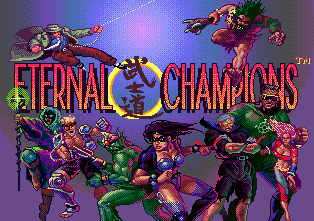
Slash is a caveman from, naturally, the dawn of man. He is really smart compared to his counterparts, but they resent him for it and eventually stone him. Trident is a genetically-engineered warrior created by the Atlantians in 110 B.C. who gets crushed with a pillar when fighting a Roman warrior in a gladiator battle over land rights. Xavier Pendragon is a brilliant alchemist who is labeled a warlock and burned to death during the Salem witch trials. Jetta Maxx is a member of the Russian royal family of 1899 who became a circus performer, only to die in an assassination due to the animosity between China and Russia. Larcen Tyler is a roaring 20’s cat-burglar who refuses to kill, set up by his boss to deliver a package that ends up being a time bomb that kills Tyler and the chief of police. Shadow Yamoto is a modern-day ninja who is thrown off a rooftop for questioning her superiors and threatening to blow the whistle on them. Jonathan Blade is a bounty hunter tasked with hunting down a mad scientist with a deadly virus, only to be double-crossed by the government, shot to death by lasers and ends up dying with the knowledge that the virus will be unleashed. Mitchell Midleton Knight, also known as Midnight is a scientist who creates a virus that turns people into vampires, which the government uses in the Vietnam War. Midnight spends many centuries trying to find a cure, but then gets taken out by a government operative. Then there’s R.A.X. Coswell, a kickboxer from 2345 who became a cyborg due to cyber-sports removing relevance from all other sports. Before he can become champion, his manager turns on him by uploading a computer virus into his system and shutting him down for good.
All of the comics are written by Michael Cook with a plethora of different artists at work. For the first arc, he’s helped by Brian Williamson, Steve White, Bambos Georgiou, John M. Burns and Jon Haward. And that’s 30 pages worth of comics! The first run takes place over the course of Sonic the Comic #19-24 starting in February of 1994. The story itself takes place in 1994… which makes it the present.
It begins the way your usual super-team intro scene goes. A villain talks about how his plan is going smoothly. Then the heroes bust through the wall and start fighting nameless henchmen. Banter is had and arguments ensue. This includes R.A.X. verifying with Shadow that he did a good job, which is his sloppy way of trying to flirt with her. While she insults him back, it’s established that they’re the obligatory would-be couple of the team. That’s right, “team”. Instead of murdering each other into oblivion, the nine Champions act as a team of Booster Golds.
So anyway, fighting and banter.
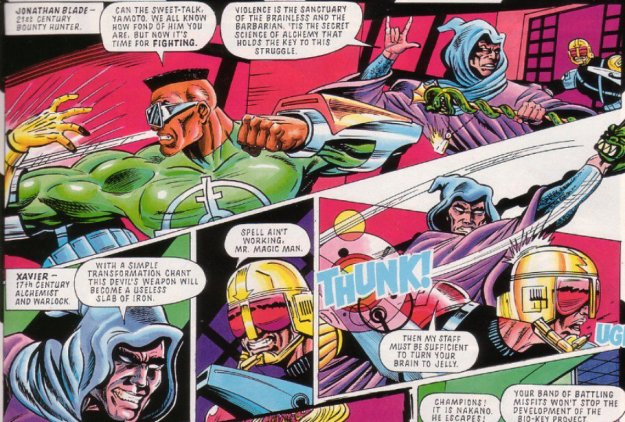
The silliest part here is Midnight’s role in the fight. When someone gets bloodied up, Midnight starts to smell the blood and almost goes into a frenzy from his thirst. This is supposed to be a major problem for the Champions, which makes me wonder why they even keep him around. They came there to fight a bunch of guys and when you fight a bunch of guys, blood happens! Don’t bring Vampire Monterey Jack if he turns into an unpredictable monster at the sight of blood!
They’re out to stop a guy named Nakano whose Bio-Key project will bring doom to the future by helping the creation of someone called Overlord. Nakano escapes the battle in Dr. Wily fashion in that he leaves his headquarters for the more dangerous hideout. This leads to even more fighting and banter. See?

Finally, something of note happens to push the story along. One of those big robots stuns Shadow with a laser and grabs her. Slash does his “HULK SMASH!” routine and gets the same treatment. Blade is warned to step back so they can regroup, but he doesn’t listen and also gets laser’d. R.A.X. is pissed and is ready to kick some ass on his own, especially with his love interest on the line, but Larcen convinces him to settle down. R.A.X. takes the time travel doohickey and comes up with a new plan, which actually doesn’t sound so bad: go to his time deep into the future and pick up some weapons that make Nakano’s robots look like sticks and stones.
Unfortunately, with R.A.X.’s lack of subtlety, it turns into a disaster. Though he and the others get some weapons, they’re ambushed by some guards who will give them a fighting chance against each other in the same arena that brought R.A.X. his death. Plus… his plan no longer seems necessary in retrospect, considering how easy Shadow and the others escape Nakano.
Nakano tries to brain-scan Shadow, Slash and Blade to see what Shadow’s plans are, but Shadow protects herself with ninja mind powers, Blade doesn’t seem to know anything and all they get from Slash are images of fire. They up the juice on the machines and all it does is drive Slash wild to the point that he breaks his restraints and goes on a rampage.
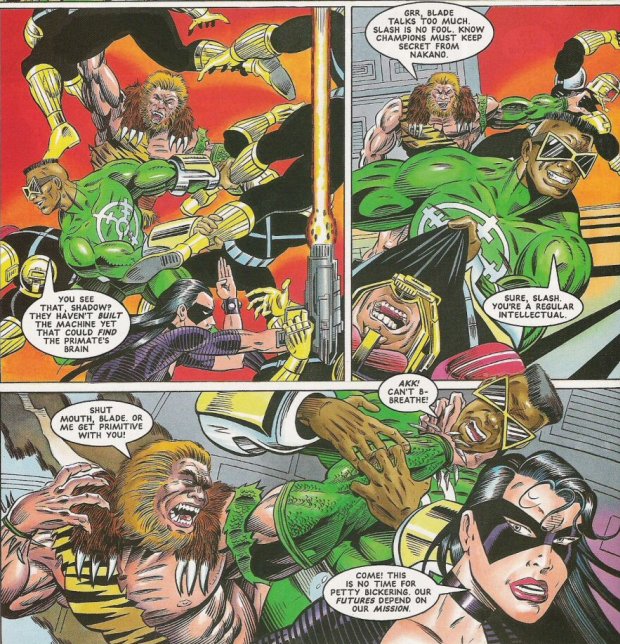
Back in the future, R.A.X. and the others are paired up into three different matches. Larcen tries to convince Jetta to take the fall and pretend to be hurt, but she feels her womanhood threatened and kicks his ass in return. The second match has Midnight beat down Xavier and tells him to stay down because the idea of magic beating science would come off as too unrealistic for those watching. Xavier takes him out in response. During this match, in their holding cell, Larcen is a bit perturbed by his loss and admits to R.A.X. that having died before, he’s not exactly thrilled with being sentenced to death. R.A.X. says it won’t be until after the last match and he’ll have a plan by then.
His plan works, although it’s so simplistic that it makes you wonder why nobody’s thought of it first. He and Trident get ready for their fight and promise to pull their punches. R.A.X. immediately forgets about that when a fan heckles him for hanging out with the rookies, but that’s okay because the plan, like I said, is incredibly simplistic.
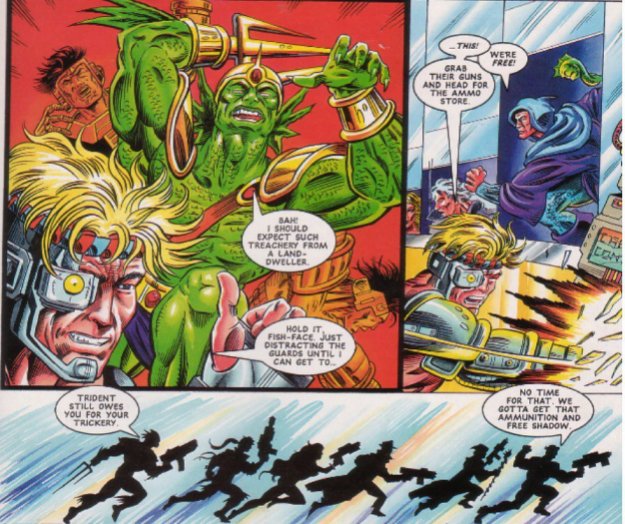
Yep. Blow up the control console and escape. Though the Champions then have to contend with some of the other competitors who didn’t have a chance to compete because of them. These goons are beaten pretty easily and R.A.X. figures that maybe they can use these guys’ weapons to help save the already-saved Shadow. Midnight points out that it isn’t so easy, since these weapons are grafted to their bodies. Trident sees no challenge in that conundrum and just tears the gun arm off one of them. They time travel back to ’94 and meet up with Shadow, Slash and Blade.
Shadow has destroyed most of the Bio-Key files, but there might still exist a couple prototypes that need to be taken care of. Nakano appears in a big, domed, weaponized aircraft and finally explains what the hell Bio-Key even means.
“Bio-Key places hard mechanics under direct organic control. Neural sensors scan my mind patterns for battle orders. Navigation controllers map my chosen flight path direct from the surface of my brain. I can lock and launch missiles with a thought and a glance. Machine and mind work in complete harmony.”
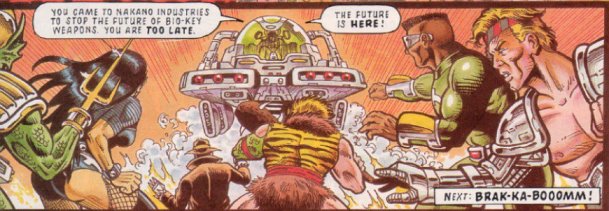
Their projectile attacks do nothing to the craft, including Trident’s future laser gun. Nakano says this is because the hull is made of adamantium. Wait… are they allowed to say that? I thought Marvel had the market cornered on that.
Nakano dominates all of them, except Trident, who attaches himself to the back, where there are no weapons to hit him. Nakano figures he’ll bring the thing underwater to shake him off, but we’re talking about a green version of Namor here. He smashes through the dome, talks down at Nakano for his love of war and then fires the future gun at Nakano’s controls. The ship explodes, sending Trident to the surface. He’s badly hurt, but says that the deed is done. Midnight is the one to point out how injured Trident is, though conveniently, he doesn’t seem to remember that he’s a vampire and blood makes him go cuckoo for Coco Puffs.
Shadow says that Nakano isn’t confirmed dead and they should make sure, but with Trident injured, they really need to go. If only they could, you know, split into groups. Like they did twenty minutes ago. Or if they could, say, time travel back to base, recoup and then time travel back to when they left. Hey, what do I know? Either way, they end up failing. Nakano survives and ends up in a cybernetic wheelchair and in the style of Terminator, his company’s technology moves forward even faster thanks to that future gun that Trident left in the water. Oops.
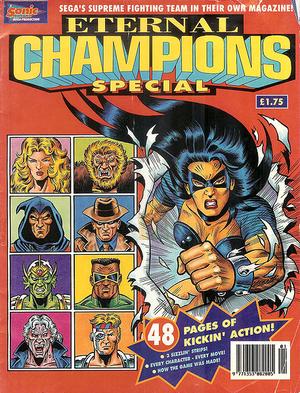
Not really off to a good start here, but thankfully, it gets a lot better. Next up is the Eternal Champions Special, which came out in spring of 1994. This one has three stories in it, plus some extras. First up is Death Isn’t Forever, which has art by Jon Haward. This is the origin story of the Eternal Champions, starting off with a page of everyone experiencing their deaths.
He brings them in and goes over the exposition. The Eternal Champion lives in a time where the world is run by the Overlord, who we never hear much about. He’s never shown and we don’t even know if he’s a really evil dude or a corrupt artificial intelligence or a demon or what. But everything sucks because he’s in charge. R.A.X. is sick of all this talking and gets aggressive. Over the course of a page, the Eternal Champion whups him badly. He’ll grant a second chance at life against whoever can win his little tournament. They’re all given access to a training facility that acts much like the X-Men’s Danger Room, though without all the hologram settings.
Shadow trains for a bit on her own, then gets annoyed and threatened when Larcen appears, clapping at her skills. He treats the whole thing fairly lightly, which gets on both Shadow’s nerves and Midnight’s.
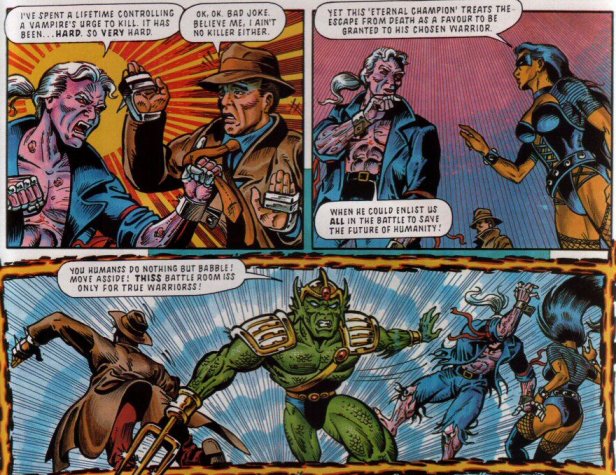
See? Not only do these guys know that the game’s plot is bullshit, they also know that Countdown: Arena made no sense. Actually… wow. Eternal Champions really is a time travel version of that comic, only not nearly as terrible.
Lots of training ensues and the Eternal Champion says it’s time for the tournament to begin. Since Trident’s gotten the highest scores from the simulators, he gets a bye. The first round of the tournament is represented through a series of single panels. Larcen defeats Blade, Midnight defeats Jetta and Shadow defeats Slash. Like idiots, R.A.X. and Xavier knock each other out somehow. They’re sent back to their times to endure their deaths, as viewed by the surviving competitors via monitors. Tyler is wide-eyed, Midnight and Shadow shield their eyes and Trident doesn’t give a damn because they’re a bunch of losers.
The three human Champions talk it over that night and agree that they should petition the Eternal Champion into letting them all join forces instead of this Thunderdome crap. They don’t ask Trident, since he feels like he’s going to win regardless.
The next day, Shadow and Trident have a more competitive fight that ends with Shadow as the winner. She tells the Eternal Champion that she doesn’t want to fight anymore and he’s fine with disqualifying her. Larcen says that he and Midnight aren’t going to fight either, only when he asks Midnight to back him up, Midnight’s too busy paying attention to the little bit of blood crawling down Trident’s lip. For fuck’s sake!
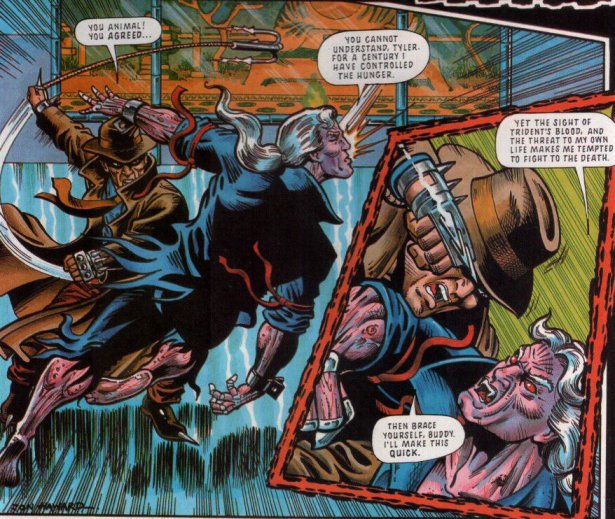
Midnight zaps Larcen with his vampire heat vision and gets ready to chomp on him, but the Eternal Champion teleports Larcen away from being food for the immortals (yay!) so he can go back to being blown to smithereens (boo!). Shadow has no choice but to fight Midnight for the finals. It’s a fight without banter of any kind between two evenly matched fighters, but Midnight is able to land the winning blow. The Eternal Champion demands he take her life. May I remind you, he’s supposed to be like the embodiment of goodness!
Midnight refuses. He comes to his senses and says that he won’t betray another ally. He explains that they wanted to be a team and if the Eternal Champion can’t accept that, then he bequeaths his winner’s spot to Shadow.
The Eternal Champion is all of the sudden okay with this because Shadow and Midnight have both chosen life over death. He summons back the other seven and says that it’s up to Shadow and Midnight to teach their comrades to follow their lead. And thus, the Eternal Champions are born!
Next up is Reality Check, a short story with art from Brian Williamson, Stephen Baskerville and Dondle Cox. R.A.X. defeats Shadow in a sparring session and insists that the deal was that he got to take her out for a date if he won. She’s against it, but the Eternal Champion is surprisingly encouraging of the idea. It’s a good way for them to see the Overlord’s world firsthand.
They come across the Dream Bank, which is like a bar with a robot bartender where all the patrons are hooked up to virtual reality devices that act like a drug. They’re all so strung out on these headsets that our heroes even come across a dead body still plugged in. The bartender sees that the Champions disagree with this business and sends an army of robot guards after them. Shadow is momentarily taken over.
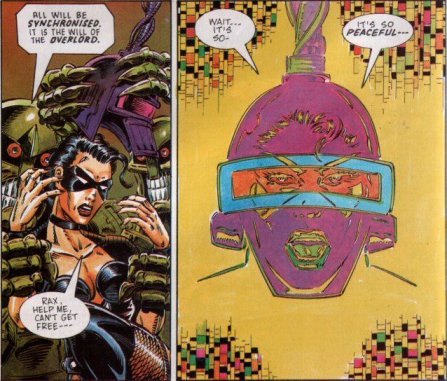
R.A.X. frees her and Shadow shows complete disgust in what she’s experienced. They save the other patrons, who shake the cobwebs and help take out the robots. With the battle won, Shadow and R.A.X. have a better idea of what they’re up against, though this is only a drop in the bucket when it comes to defeating the Overlord for good.
In-between the different stories, we’re given two extra bits. The main one is a set of character profiles. These are really well done, featuring a pinup of each character, in-game screenshots, movelists, damage percentages of all their special moves, fighting styles, backstories, personalities and likes/dislikes. There’s definitely a lot of thought put in here by Michael Cook and it makes me wish more stories were written to delve into the character relationships he had come up with based on their various personalities.
For instance, Shadow and Jetta have a kinship over being the two ladies of the team. R.A.X. obviously has a thing for Shadow, but she also likes him more than she puts on. Larcen is so in the background in the way he handles himself that nobody has an opinion on him one way or the other, outside of Jetta. The two share a respect and potential romantic relationship based on their similar opinions on society. Jetta is practically racist against Midnight for being a vampire and isn’t crazy about Slash either, though Slash is attracted to her. Slash, Trident and R.A.X. are a clique of sorts, based on being the three characters who love to solve all their problems with fighting. Meanwhile, Xavier and Midnight share a friendship based on their intellectual natures. Naturally, that pairing is always at odds with the more violence-loving trio. And for Blade? He, um…
Yeah, Jonathan Blade is practically forgotten about. He barely does anything in these comics and comes off as an afterthought. Under “Likes/Dislikes” (which are listed separate for the other characters), it says for Blade, “None that he will admit to.” It’s like Cook would be writing then realizing every now and then, “Oh, right. Jonathan Blade exists. He needs a line of dialogue.”
One thing that they go overboard with is how most of their dislikes are based on their deaths. Larcen hates explosions. Shadow and Jetta hate heights. Xavier hates fire. So on and so forth. We get it.
The other feature is a 3-page interview with the game’s producer Michael Latham. There’s nothing too notable about his anecdotes, but it does show some interesting concept art of costumes and characters never used. They once considered having Xavier wear a dress and Jetta was originally going to be an Emma Peel-like spy, probably from the 1960’s. Other failed concepts include a pirate with a parrot on his shoulder, an Aztec warrior and… um… George Clinton?

Yep. Focus groups did not like that.
The third and last story of the special issue is Brains ‘n’ Brawls, with art by Brian Williamson, Bambos Georgiou and Una Fricka. This one focuses on one of the inner-team rivalries mentioned in the profiles in the form of Xavier and Slash.
Jetta hears screams and sees Slash stuck in the training room, angrily attacking machines and dodging missiles, but still taking his share of damage. Xavier has been watching this for quite a while and finds it humorous as Slash can’t figure out how to turn off the program and get out. Jetta is disgusted by this attitude, gets in there and saves Slash. Once the program is turned off, Slash collapses. Jetta sees that he’s been logged in there for five hours, though Xavier fails to see anything to get worked up about. If Slash can’t figure out futuristic machinery, how is he supposed to help fight Overlord?

There’s an interesting clash here with Slash’s endings in the two games. In them, it says that he’s actually learned much from Xavier and that Xavier is the one who taught him the secret to creating fire. It could be that the comic was going to work towards building a kinship between the two over time to meet with that, but who knows.
The Eternal Champion confronts Xavier about his cold treatment of Slash, which Xavier shows no remorse for. Slash is mentally inferior and he left him to die in order to prove it. Slash gets out of his bed and the two start fighting until the Eternal Champion stands between them. He figures there needs to be some kind of solution.
Blade and Midnight work on adding controls to the training programs that even Slash can follow, though they don’t think it will work out. Slash fiddles around with it, claiming he thinks he has it figured out, but then he gets a big error message. Xavier laughs at what a joke he is and how they’ll never work as a team. The Eternal Champion chides him and Xavier backtracks. Maybe they can’t see eye-to-eye, but a sign of respect couldn’t hurt. He holds his hand out to shake with Slash. Slash is about to follow suit…
Then he picks him up and throws him into the training room. He uses the controls and makes sure that Xavier gets what’s coming to him. The program won’t turn off until sunset. Xavier dodges missiles while angrily swearing that he’ll make Slash pay.
Watching him frantically endure the onslaught, Slash laughs. “Wizard have to get up very early to outsmart Slash!”
In the games, I’ve always seen Xavier as the main hero. Like, the one who’s supposed to win. You can usually tell in these games by whichever character is the most generic. So it’s strange to see him depicted as an inept dickhead with his head up his ass. Oh, well.
The final story takes place in the pages of Sonic the Comic #37-40, released in October of 1994. It’s called Larson’s Revenge with art by Jon Haward. Yes, they actually spelled the main character’s name wrong in the title and didn’t notice during the entire four issues! This is a very different story from the rest, but probably the best. As the story goes, the Champions defeated the Overlord at some point. Zero detail is given on this one. The Eternal Champion was so grateful that he allowed all nine warriors to live their lives. Only instead of returning them back a moment before they died like in the game, he went about it a different way. They each get a new lease on life, existing in their eras post-death.
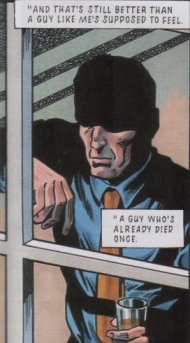
Larcen Tyler has it rough. Sure, he’s back from the dead, but if anyone gets wind that he’s alive, he won’t last long. He’s been hiding out in a crappy apartment since returning, too afraid to go outside during the day. Then he receives an envelope with no traceable clues. Just a bunch of money and instructions to steal from some criminal calling him or herself the White Orchid. Confused but intrigued, he follows the directions and gets to business.
He beats up a couple of the White Orchid’s goons and sneaks into an office to get at some top secret documents. Suddenly, the lights turn on and he’s given quite the surprise.
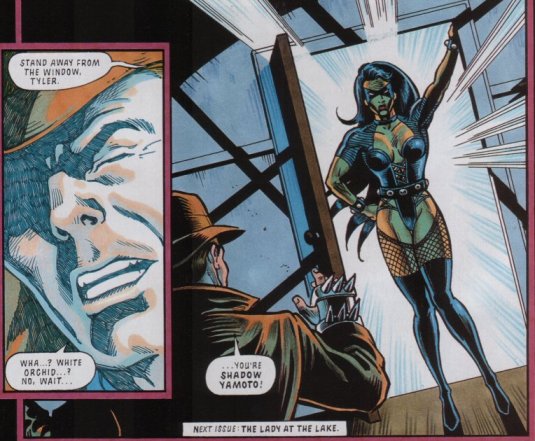
And shit just got real.
Shadow says that even though the Eternal Champion sent everyone home, he kept her around. Larcen’s traitorous boss Mr. Tagliani needs to be taken down and it has to be done without Larcen’s involvement. Under the guise of the White Orchid, Shadow has put together her own organization, but can’t go further into the details.
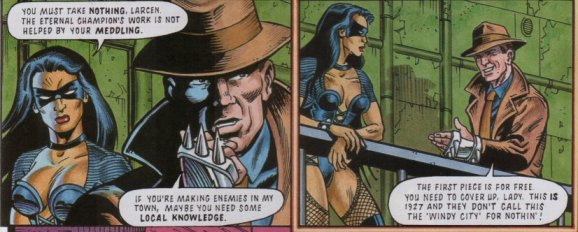
Even Larcen Tyler thinks female fighting game characters are too scantily clad.
Shadow needs to meet with someone, though she can’t shake Larcen, who wants to know how people know he’s alive. Her expected underworld meeting is only a setup as the cops show up and ambush them. Larcen easily fights them off and escapes, but is surprised to see Shadow let herself get caught.
Larcen breaks into the local jail, beats up his share of cops and releases Shadow. While they escape, she yells at him for ruining everything. All this time as the White Orchid, she had been putting together dossiers and evidence against all of the Chicago criminals so that she could hand it to the prosecution while confessing to her own crimes. Running from the law now makes her look bad and makes her testimony useless. Larcen thinks it’s probably for the better, since someone set them up earlier anyway. There’s more to this than they know.
When they reach Larcen’s place to hide out, they’re greeted with Mr. Tagliani and a lot of armed thugs. Larcen and Shadow fight off a bunch of them and Larcen slugs his old boss one in the face, but a pistol whip to the back of the head knocks the cat burglar unconscious. It looks like Shadow was overpowered by the numbers game.
The two are gagged and driven across town while Mr. Tagliani explains the plot. He had heard that Larcen was somehow back and he also knew that this White Orchid lady was challenging his turf and had some documents that could put him away. He had the perfect plan in setting them up against each other. Larcen is the only burglar skilled enough to steal the documents, so he could conceivably pull it off, deliver the goods and then get shot to death as payment. If he failed, he was dead and the White Orchid would be arrested thanks to Tagliani tipping off the police like he did. He’d win either way. He didn’t foresee that they’d work together, so he’ll have to take care of that himself.
Tagliani has the car filled with dynamite and steps out. He rolls it down a hill, where it’s going to collide with Shadow’s underworld complex and explode, taking out the two Champions and any evidence against Tagliani. Normally, Larcen is a pretty cool guy, but being in this situation terrifies him.
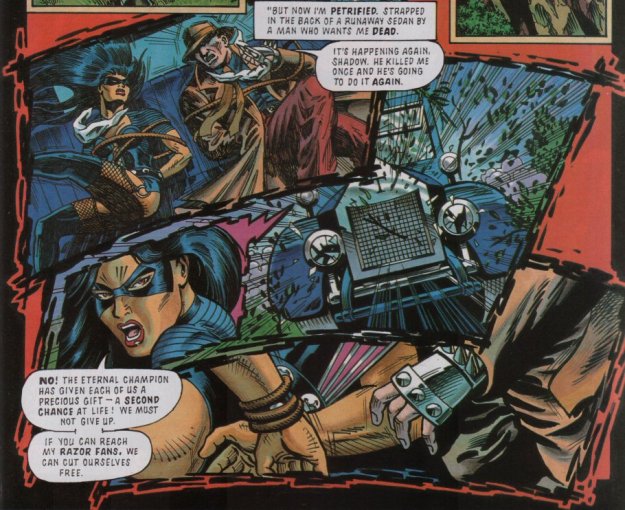
Larcen breaks down in front of Shadow, saying that no matter what kind of second chance he gets, he’ll always be bested and murdered by that scum Tagliani. It’s his destiny to die like this. Shadow gets them untied and gets his head in the game, just in time for them to escape the barreling car of explosives.
It hits the building and explodes. Shadow laments over the loss of her incriminating documents, but Larcen pulls them out of his trench coat. When asked how he could have possibly stolen them when she was in the room with him earlier, Larcen smirks and tells her, “Trade secrets, lady. Told you I’m the best!”
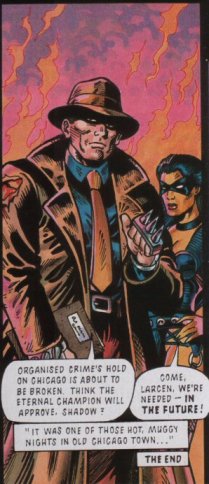
So ends the comic book exploits of the Eternal Champions. It was never going to light the world on fire, but I think it had potential in it and I’m a little disappointed to see it finish up so early on. I think it could have made for a fun team book with era-specific adventures like Larcen’s faux-noir story arc. Especially if Jon Haward continued to draw the brunt of it.
What of the Eternal Champions franchise itself? In 1995, the sequel/revision Eternal Champions: Challenge of the Dark Side was released for Sega CD. The story is a time travel mindfuck based on the idea that the first game created a time loop no matter who won and that a guy called the Dark Champion has shown himself and introduced more competitors to the tournament. Through the inclusion of the new character Thanatos, the game’s backstory was explained a little better. Thanatos used to be the Grim Reaper until some unknown force stole his role and powers and went on to kill all the Eternal Champions throughout history before they were meant to die. Thanatos’ ending suggests a big team-up with the Eternal Champion, Xavier and new character Raven to hunt down this force and set everything right. Hey, closure!
The endings in the game for older characters were rewritten, mostly coming off as more cynical. Rather than helping destroy almost every disease, Midnight would become mankind’s only hope in a never-ending war against vampires. Instead of destroying corruption in the police force, Blade would spend the rest of his life as a bounty hunter hunted down by the law. Instead of ending the war between Atlantis and Rome with an inspirational speech, the seemingly-immortal Trident would hide underwater until mankind could come to its senses. One of the more interesting changes would be for Shadow Yamoto’s ending, which had her join an espionage team called X-Perts.
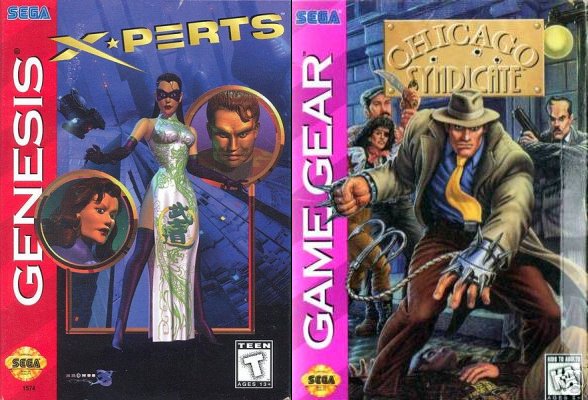
In 1996, Shadow would star in a Genesis game of that name, which is based on her ending being true. Similarly, Larcen Tyler would get his own Game Gear game called Chicago Syndicate, also based on the idea that his ending happened. The less said about these games, the better.
A third and final game was being worked on for the Sega Saturn that would have involved Thanatos and the others going after the new Death. It was canceled, reportedly because someone at Sega decided that because the company had Virtua Fighter, there should only be one fighting game franchise. Yes, that was the decision during the mid-to-late 90’s when fighting games were all over the place. There can be only one. Thank God that guy didn’t work for Capcom or SNK.
I can’t find myself disappointed in that. Look at it this way. This comic could have shined had it gone on further and developed the relationships that the profiles hinted at. There could have been some really cool story arcs, but instead, it stopped being made. A game meant to end the series’ story was being put together, only to be cut down before it had a chance.
For Eternal Champions, a game about a bunch of folks who were killed before they could reach their potential, can you think of a more fitting way to end it?

“Vampire Monterey Jack”
Niiiiice.
Honestly, having played the Virtua Fighter games and the Eternal Champions games, I think Sega made the right choice. I never had a Genesis growing up, so I didn’t get to play Eternal Champions when it was new. After years of waiting, when I finally played it, holy crap did it piss me off.
When I bought a Genesis (used at a Funcoland around 2000; I had an SNES during the 16-bit era) I made sure to get only six-button pads. Turns out EC is practically unplayable on one. Many of the special move commands expect you to do things like holding X, Y and B while making a controller motion. On an arcade stick? Possible, though likely annoying. On a pad? Good luck with that. This is made extra infuriating by the fact that Eternal Champions was never in arcades. Did they really expect people to only play with a tree button pad or an arcade stick? Was there even a first party stick? I don’t remember Sega putting out their own.
So, here I am, pretty much incapable of using special moves, and I discover another fun fact: when you lose, rather than trying the same match again, the game sends you back a match. It’s entirely possible to nearly beat the game, then have a run of bad luck (or get frustrated and play sloppily) and find yourself back at the first match. Unless, of course, you’re fighting the Eternal Champion. Not only is he ridiculously cheap, losing to him gets you an instant game over. Seriously? Who thought this was a good idea?
Sorry to rant about the game after an article about the comics, but it just made me so angry. Challenge from the Dark Side fixes some of the first game’s problems, but it still isn’t really good enough to stand out from all the other titles that came out at the time. Even as ignored as it tends to be today, at the time Virtua Fighter was way more visible thanks to pioneering 3D fighters. I think it definitely made sense for Sega to focus on that rather than pushing ahead on trying to make what was basically already an also-ran relevant.
I know the sequel is a fighting-game favorite, but I was never fond of its decision to go so utterly over-the-top in gore. Though the original game had fatalities, they were so hard to pull off they were more like Easter eggs. The attraction of the original was its genuinely interesting premise and characters (not to mention a rather complex fighting system), and the refocus on gore in the sequel just seemed like vandalism of a good idea.
I quite enjoyed the Eternal Champions comic back in the day, but I threw out all my old Sonic comics quite a while ago, so it’s been ages since I read them.
I’m pretty sure Trident was my favourite character either because he wasn’t human, or because he was a dick(so unsurprisingly, his trouncing of the big bad guy and saving the day at the end of the first story was one of my favourite bits in the series).
“In the games, I’ve always seen Xavier as the main hero. Like, the one who’s supposed to win. You can usually tell in these games by whichever character is the most generic. ”
I’d say it’s more who’s the most “average” rather than most “generic”, though that might seem like splitting hairs. The average build(for a fighter), average height, average age, etc. Xavier seems a bit short, old and scrawny to really fit that mould.
I think I had Shadow pegged as the franchise’s main hero, possibly due to some element of the game’s presentation, or something similar. The writer for the EC comics seems to have a particular fondess for Larcen though(I’m guessing because he best fits the affable, down-to-earth sort of role amongst the game’s cast).
Over time, Sonic the Comic became more focused on Sonic, and phased out the strips based on other Sega franchises while making more strips based on Sonic’s supporting cast. That might have been another factor in there being no more Eternal Champions strips.